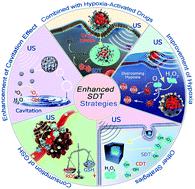当前位置:
X-MOL 学术
›
Mater. Horiz.
›
论文详情
Our official English website, www.x-mol.net, welcomes your feedback! (Note: you will need to create a separate account there.)
Newly developed strategies for improving sonodynamic therapy
Materials Horizons ( IF 13.3 ) Pub Date : 2020-06-15 , DOI: 10.1039/d0mh00613k Xianwen Wang 1, 2, 3, 4, 5 , Xiaoyan Zhong 6, 7, 8, 9, 10 , Fei Gong 1, 2, 3, 4, 5 , Yu Chao 1, 2, 3, 4, 5 , Liang Cheng 1, 2, 3, 4, 5
Materials Horizons ( IF 13.3 ) Pub Date : 2020-06-15 , DOI: 10.1039/d0mh00613k Xianwen Wang 1, 2, 3, 4, 5 , Xiaoyan Zhong 6, 7, 8, 9, 10 , Fei Gong 1, 2, 3, 4, 5 , Yu Chao 1, 2, 3, 4, 5 , Liang Cheng 1, 2, 3, 4, 5
Affiliation

|
Sonodynamic therapy (SDT) is a new therapeutic method, which can kill malignant tumors by using sonosensitizers and low intensity ultrasound (US) simultaneously. Compared with photo-triggered therapy, SDT exhibits lots of benefits and merits, including high accuracy, deeper tissue penetration, good patient compliance, and fewer side effects. US can penetrate the deep tissues and focus on the tumor areas, thereby activating sonosensitizers, which offers the possibility of non-invasively eradicating solid tumors in a targeted manner. However, the hypoxic tumor microenvironment (TME) and the low quantum yield of sonosensitizers limit the treatment efficiency of SDT. Therefore, it is crucial to improve the sonodynamic effect. In this minireview, we briefly introduce the possible mechanisms of SDT, including the production of reactive oxygen species (ROS), cavitation effect, and hyperthermia destruction. Then we summarize various newly developed strategies to improve the efficacy of SDT through the use of sonosensitizers based on the mechanisms of SDT, providing a theoretical basis for the development of SDT in the future. The strategies to improve the therapeutic efficiency of SDT mainly include: (1) improvement of hypoxia; (2) enhancement of the cavitation effect; (3) consumption of reducing substances (e.g., glutathione, GSH); (4) combination with hypoxia-activated chemotherapeutic drugs; and (5) combination with immunotherapy. In addition, we also focus on the potential strategies of combining SDT with other therapies, and discuss the challenges and limitations of SDT in future clinical applications.
中文翻译:

最新开发的改善声动力疗法的策略
声动力疗法(SDT)是一种新的治疗方法,可以同时使用声敏剂和低强度超声(US)杀死恶性肿瘤。与光触发疗法相比,SDT具有许多优点和优点,包括准确性高,组织穿透更深,患者依从性好以及副作用少。US可以穿透深层组织并集中在肿瘤区域,从而激活声敏剂,从而有可能以靶向方式无创根除实体瘤。然而,低氧肿瘤微环境(TME)和声敏剂的量子产率低限制了SDT的治疗效率。因此,提高声动力效果至关重要。在本微型评论中,我们简要介绍了SDT的可能机制,包括活性氧(ROS)的产生,空化作用和高温破坏。然后,我们总结了基于SDT机理通过使用声敏剂提高SDT疗效的各种新策略,为将来SDT的发展提供了理论基础。提高SDT治疗效率的策略主要包括:(1)改善缺氧;(2)增强空化作用;(3)消耗还原物质(提高SDT治疗效率的策略主要包括:(1)改善缺氧;(2)增强空化作用;(3)消耗还原物质(提高SDT治疗效率的策略主要包括:(1)改善缺氧;(2)增强空化作用;(3)消耗还原物质(例如,谷胱甘肽,GSH);(4)与缺氧激活的化疗药物合用;(5)结合免疫疗法。此外,我们还将重点研究将SDT与其他疗法结合的潜在策略,并讨论SDT在未来临床应用中的挑战和局限性。
更新日期:2020-08-03
中文翻译:

最新开发的改善声动力疗法的策略
声动力疗法(SDT)是一种新的治疗方法,可以同时使用声敏剂和低强度超声(US)杀死恶性肿瘤。与光触发疗法相比,SDT具有许多优点和优点,包括准确性高,组织穿透更深,患者依从性好以及副作用少。US可以穿透深层组织并集中在肿瘤区域,从而激活声敏剂,从而有可能以靶向方式无创根除实体瘤。然而,低氧肿瘤微环境(TME)和声敏剂的量子产率低限制了SDT的治疗效率。因此,提高声动力效果至关重要。在本微型评论中,我们简要介绍了SDT的可能机制,包括活性氧(ROS)的产生,空化作用和高温破坏。然后,我们总结了基于SDT机理通过使用声敏剂提高SDT疗效的各种新策略,为将来SDT的发展提供了理论基础。提高SDT治疗效率的策略主要包括:(1)改善缺氧;(2)增强空化作用;(3)消耗还原物质(提高SDT治疗效率的策略主要包括:(1)改善缺氧;(2)增强空化作用;(3)消耗还原物质(提高SDT治疗效率的策略主要包括:(1)改善缺氧;(2)增强空化作用;(3)消耗还原物质(例如,谷胱甘肽,GSH);(4)与缺氧激活的化疗药物合用;(5)结合免疫疗法。此外,我们还将重点研究将SDT与其他疗法结合的潜在策略,并讨论SDT在未来临床应用中的挑战和局限性。



























 京公网安备 11010802027423号
京公网安备 11010802027423号